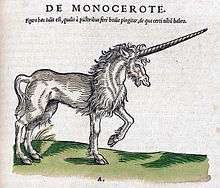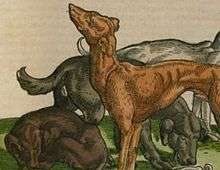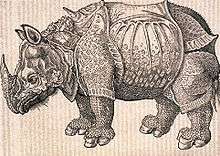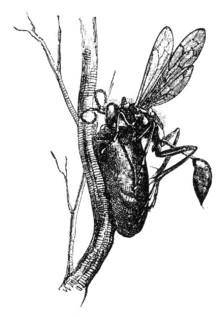Historia animalium (Gessner)
Historia animalium ("History of the Animals"), published at Zurich in 1551–58 and 1587, is an encyclopedic "inventory of renaissance zoology" by Conrad Gessner (1516–1565). Gessner was a medical doctor and professor at the Carolinum in Zürich, the precursor of the University of Zurich. The Historia animalium is the first modern zoological work that attempts to describe all the animals known, and the first bibliography of natural history writings. The five volumes of natural history of animals cover more than 4500 pages.[1]
Context
There was extreme religious tension at the time Historia animalium came out. Under Pope Paul IV it was felt that the religious convictions of an author contaminated all his writings,[2] and as Gessner was a protestant, it was added to the Catholic Church's list of prohibited books.[3]
Overview

The Historia animalium was Gessner's magnum opus, and was the most widely read of all the Renaissance natural histories. The work was so popular that Gessner's abridgement, Thierbuch ("Animal Book"), was published in Zurich in 1563, and in England Edward Topsell translated and condensed it as a Historie of foure-footed beastes (London: William Jaggard, 1607).[1] Gessner’s monumental work attempts to build a connection between the ancient knowledge of the animal world, its title the same as Aristotle's work on animals, and what was known at his time. He then adds his own observations, and those of his correspondents, in an attempt to formulate a comprehensive description of the natural history of animals.[4]
Gessner’s Historia animalium is based on the Old Testament as well as classical sources. It is compiled from folklore alongside ancient and medieval texts, including the inherited knowledge of ancient naturalists like Aristotle, Pliny the Elder,[1] and Aelian.[4] Gessner was known as "the Swiss Pliny."[3] For information on mythical animals he relied heavily on the Physiologus.[3]

Though in his large work Gessner sought to distinguish facts from myths, his encyclopedic work also included mythical creatures and imaginary beasts, intermixed with the strange newly discovered animals of the East Indies, those of the far north and animals brought back from the New World. The work included extensive information on mammals, birds, fish, and reptiles. It described in detail their daily habits and movements. It also included their uses in medicine and nutrition.[1]
Historia animalium showed the animals' places in history, literature and art. Sections of each chapter detailed the animal and its attributes, in the tradition of the emblem book. Gessner's work included facts in different languages such as the names of the animals.[5]
Contents
- Volume 1 is on live-bearing four-footed animals (1551).
- Volume 2 is on egg-laying quadrupeds (reptiles and amphibia) (1554).
- Volume 3 is on birds (1555).
- Volume 4 is on fish and aquatic animals (1558).
- Volume 5, on snakes and scorpions, was published in 1587, after Gessner’s death.
Illustrations

The colored woodcut illustrations were the first real attempts to represent animals in their natural environment. It is the first book to illustrate fossils.[5][6]
Gessner acknowledges one of his main illustrators was Lucas Schan,[7] an artist from Strasbourg. He likely used other illustrators as well as himself;[3] the book is however famous for copying illustrations from other sources, including Durer's Rhinoceros from a well-known woodcut.[4] Gessner's natural history was unusual for sixteenth century readers in providing illustrations.[3]
References
- 1 2 3 4 "Featured book archive: Historia animalium libri I-IV. Cum iconibus. Lib. I. De quadrupedibus uiuiparis. Zurich: C. Froschauer, 1551. N*.1.19(A)". Cambridge University Library. Retrieved 29 November 2014.
- ↑ Schmitt, p. 46,
- 1 2 3 4 5 "Conran Gessner biography". Retrieved 2008-09-17.
- 1 2 3 Huxley, 2007. Pages 71–75
- 1 2 Anzovin, p. 366 item 5210 The first fossil illustrations were contained in the Historia animalium, published in 1551 by Swiss physician and naturalist Conrad von Gessner.
- ↑ Tallack, Peter, The Science Book, Sterling Publishing Company, 2006, ISBN 1-84188-254-2, p. 46 Gessner’s classical training taught him to give pride of place to naming and classifying the fossils he described. Most importantly, he was concerned with precise identification. His book was the first to present fossil illustrations so students may more easily recognize objects that cannot be very clearly described in words.
- ↑ Kusukawa, S. (July 2010). "The sources of Gessner's pictures for the Historia animalium" (PDF). Annals of Science. 67 (3): 303–328. doi:10.1080/00033790.2010.488899.
Sources
- Anzovin, Steven (2000). Famous First Facts. H. W. Wilson. ISBN 0-8242-0958-3.
- Daston, Lorraine; et al. (2001). Wonders and the Order of Nature, 1150-1750. Zone books. ISBN 0-942299-91-4.
- Eamon, William (1994). Science and the Secrets of Nature: Books of Secrets in Medieval and Early Modern Culture. Princeton University Press. ISBN 0-691-02602-5.
- Fudge, Erica (2004). Renaissance Beasts: Of Animals, Humans, and Other Wonderful Creatures. University of Illinois Press. ISBN 0-252-02880-5.
- Gmelig-Nijboer, Caroline Aleid (1977). Conrad Gessner's 'Historia animalium': an inventory of renaissance zoology. Meppel.
- Gessner, Conrad; et al. (1971). Curious Woodcuts of Fanciful and Real Beasts - A Selection of 190 Sixteenth-century Woodcuts from Gessner's and Topsell's Natural Histories. Dover Publications. ISBN 04862270-1-4.
- Huxley, Robert; et al. (2007). The Great Naturalists. Thames & Hudson. ISBN 0-500-25139-8.
- Jardine, Secord; et al. (1996). Cultures of Natural History. Cambridge University Press. ISBN 0-521-55894-8.
- Library Company of Phil, Steven (2000). Legacies of Genius: A Celebration of Philadelphia Libraries: A Selection of Books, Manuscripts, & Works of Art. ISBN 1-151-45471-0.
- Ogilvie, Brian W. (2006). The Science of Describing: Natural History in Renaissance Europe. University of Chicago Press. ISBN 0-226-62087-5.
- Pavord, Anna (2005). The Naming of Names - The Search for Order in the World of Plants. Bloomsbury. ISBN 1-59691-071-2.
- Rudwick, Martin J.S. (1976). The Meaning of Fossils. University of Chicago Press. ISBN 0-226-73103-0.
- Schmitt, Charles B.; et al. (1990). The Cambridge History of Renaissance Philosophy. Cambridge University Press. ISBN 0-521-39748-0.
- Topsell, Edward,; Gessner, Konrad; et al. (1967). The history of four-footed beasts and serpents and insects. Da Capo Press. ISBN 0-306-70923-6.
External links
| Wikimedia Commons has media related to Historiae Animalium. |
